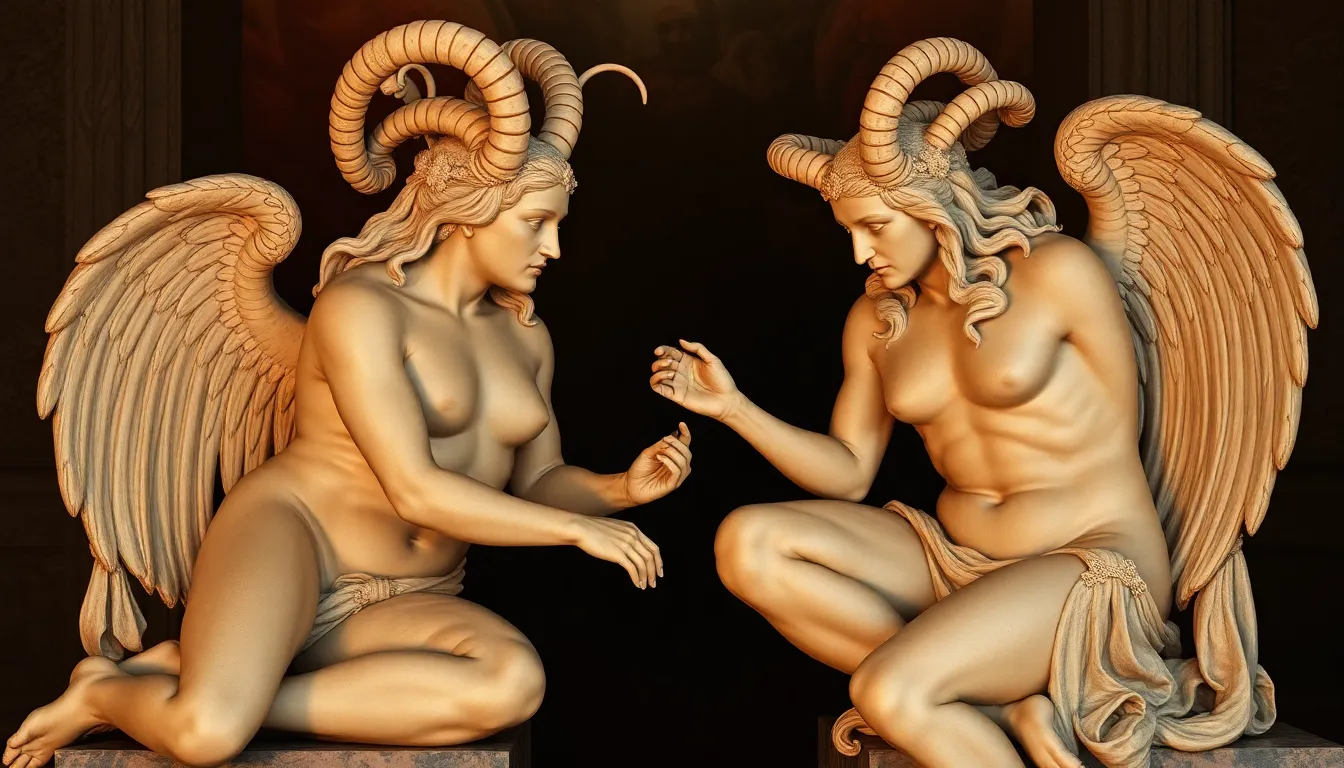Satyrs and the Art of Seduction: Myths of Love and Desire
I. Introduction to Satyrs: Mythical Beings of Desire
In the rich tapestry of Greek mythology, satyrs emerge as fascinating figures embodying the essence of desire, pleasure, and the wild aspects of nature. Defined as half-man, half-goat beings, satyrs are often depicted with goat-like features such as horns, pointed ears, and a hairy body, representing their deep connection to the natural world.
Satyrs played a significant role in ancient Greek culture, often associated with fertility, revelry, and the ecstatic worship of Dionysus, the god of wine and festivity. Their presence in art and literature highlights the importance of seduction, as they are frequently portrayed as charming and mischievous beings who pursue love and pleasure with relentless enthusiasm.
The theme of seduction is central to satyr mythology, reflecting the duality of human nature and the primal instincts that drive individuals toward desire and connection.
II. The Origins of Satyr Myths
The origins of satyr myths can be traced back to ancient Greece, where they were often linked to rustic deities and nature spirits. Historically, satyrs are believed to have evolved from earlier woodland spirits and fertility gods, representing the untamed aspects of the natural world.
Over time, the satyr archetype has evolved from ancient texts, such as those by Homer and Hesiod, to modern interpretations that continue to captivate audiences. The stories surrounding satyrs often include key figures such as Pan, the god of the wild, who shares many traits with satyrs and embodies the spirit of nature and music.
- Key Figures: Pan, Silenus, Marsyas.
- Influential Stories: The Judgment of Paris, the adventures of Dionysus.
III. Symbolism of Satyrs: Nature, Fertility, and Pleasure
Satyrs symbolize a profound connection to nature and the wilderness. They are often depicted in lush landscapes, embodying the untamed beauty of the earth. This connection to the natural world reinforces their role as fertility symbols, representing abundance and the cyclical nature of life.
Moreover, the representation of satyrs in mythology reveals the duality of pleasure and chaos. While they are associated with joyous celebrations and the pursuit of love, their antics often lead to disorder and revelry that can spiral into chaos, demonstrating the fine line between ecstasy and excess.
IV. The Art of Seduction: Techniques and Strategies of Satyrs
Satyrs are masters of seduction, employing various techniques to charm and entice those around them. Their natural charisma and charm make them appealing figures in mythological tales.
The role of music and dance is paramount in their approach, as satyrs are often portrayed playing flutes and engaging in ecstatic dances that draw others into their world. This musicality not only serves as a tool for attraction but also symbolizes the joy and freedom associated with desire.
Additionally, satyrs employ psychological tactics to understand and manipulate desire and temptation. They often embody the essence of what it means to be free and unrestrained, appealing to the deepest yearnings of those who encounter them.
V. Love and Desire in Satyr Myths: Key Stories and Characters
Numerous myths feature satyrs and their romantic pursuits, showcasing their relentless desire and often humorous encounters. One notable tale involves the satyr Marsyas, who challenged Apollo to a musical contest, a story that explores themes of hubris and desire for recognition.
The interplay between satyrs and gods or goddesses of love, such as Aphrodite, further enriches these tales. Satyrs often find themselves entangled in love stories that highlight both their charm and their chaotic nature.
- Notable Myths:
- The Contest of Marsyas
- The Seduction of Nyctimene
- Pan and Syrinx
- Goddesses of Love:
- Aphrodite
- Dionysus
VI. Satyrs in Art and Literature: Representations Through the Ages
Satyrs have been a popular subject in classical art and sculpture, often portrayed in scenes of revelry and merriment. Their depictions reflect the themes of love and desire, capturing the essence of their character as playful yet chaotic beings.
In literature, satyrs have influenced countless works from ancient texts to modern novels. Their representation as symbols of unrestrained passion has allowed them to transcend time, appearing in various forms in creative expressions.
- Classical Art: Pottery, frescoes, and sculptures often depict satyrs in lively festivities.
- Literary Influence: Writers like Ovid and Shakespeare have incorporated satyr-like characters into their narratives.
VII. Modern Interpretations of Satyrs and Seduction
In contemporary culture, satyrs have experienced a resurgence in popularity, appearing in various media forms such as film, television, and literature. Their motifs continue to resonate, reflecting modern themes of love, desire, and the complexities of relationships.
Modern interpretations often reimagine the satyr archetype, exploring themes of seduction in the context of contemporary relationships. This evolution allows for a nuanced understanding of desire, balancing the primal instincts of the past with the intricacies of modern life.
VIII. Conclusion: The Enduring Legacy of Satyrs in Love and Desire
The legacy of satyrs in mythology offers profound insights into human desire and the nature of attraction. Their stories remind us of the complexities of love, the interplay between chaos and ecstasy, and the significance of embracing our primal instincts.
As discussions of love and seduction continue to evolve, the relevance of satyrs remains significant. They serve as a reminder of the balance between nature and desire, encouraging us to explore the depths of our passions while acknowledging the chaos that often accompanies them.
In conclusion, the enduring appeal of satyrs in mythology highlights the timeless nature of love and desire, encouraging us to embrace the wild and untamed aspects of our own hearts.




